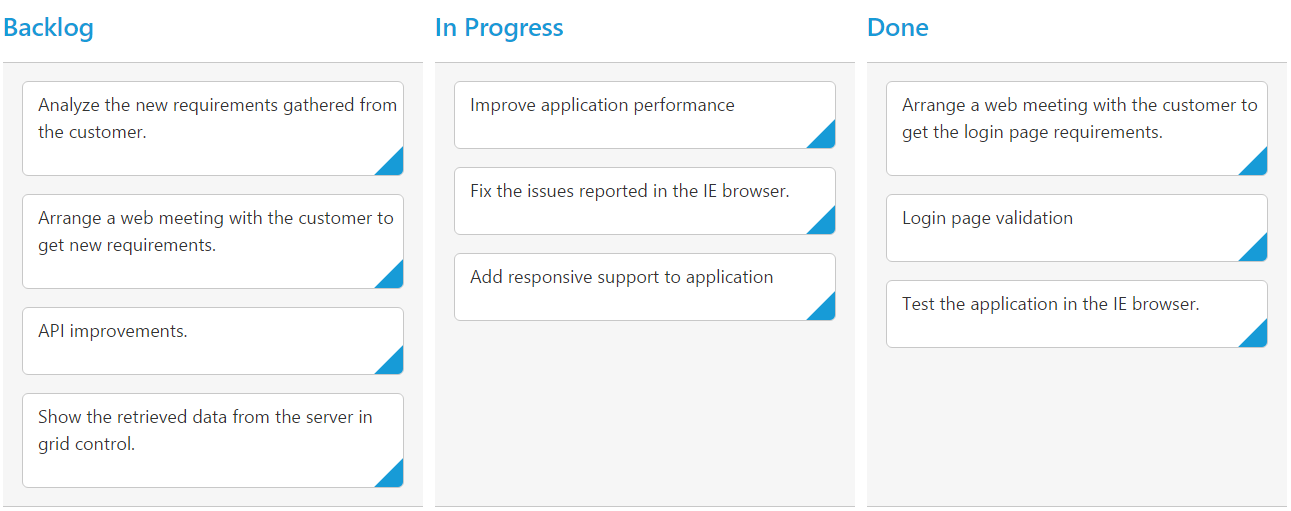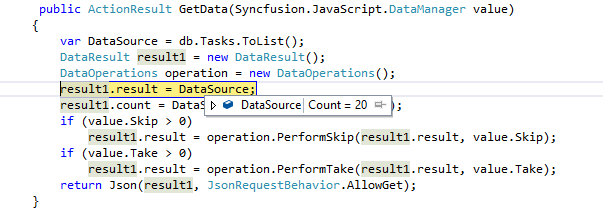Data Binding
6 Mar 201913 minutes to read
The Kanban control uses ej.DataManager which supports both RESTful JSON data services binding and local JSON array binding. The dataSource property can be assigned either with the instance of ej.DataManager or JSON data array collection. It supports different kinds of data binding methods such as
- Local data
- Remote data
Local Data
To bind local data to the Kanban, you can assign a JSON array to the dataSource property.
The JSON array to the dataSource property can also be provided as an instance of the ej.DataManager. When the JSON array is passed as an instance of ej.DataManager, the ej.JsonAdaptor will be used to manipulate the Kanban data source.
The following code example describes the above behavior.
<div id='Kanban'></div>var kanbanData = [
{ Id: 1, Status: "Open", Summary: "Analyze the new requirements gathered from the customer.", Assignee: "Nancy" },
{ Id: 2, Status: "InProgress", Summary: "Improve application performance", Assignee: "Andrew" },
{ Id: 3, Status: "Open", Summary: "Arrange a web meeting with the customer to get new requirements.", Assignee: "Janet" },
{ Id: 4, Status: "InProgress", Summary: "Fix the issues reported in the IE browser.", Assignee: "Janet" },
{ Id: 5, Status: "Testing", Summary: "Fix the issues reported by the customer.", Assignee: "Steven" }
];
$("#Kanban").ejKanban(
{
dataSource: kanbanData,
columns: [
{ headerText: "Backlog", key: "Open" },
{ headerText: "In Progress", key: "InProgress" },
{ headerText: "Done", key: "Close" }
],
keyField: "Status",
fields: {
content: "Summary",
primaryKey: "Id"
}
});The following output is displayed as a result of the above code example.

Remote Data
To bind remote data to Kanban Control, you can assign a service data as an instance of ej.DataManager to the dataSource property.
OData
OData is a standardized protocol for creating and consuming data. You can provide the OData service URL directly to the ej.DataManager class and then you can assign it to Kanban dataSource.
The following code example describes the above behavior.
<div id='Kanban'></div>$(function () {
var data = new ej.DataManager("http://mvc.syncfusion.com/Services/Northwnd.svc/Tasks");
$("#Kanban").ejKanban(
{
dataSource: kanbanData,
columns: [
{ headerText: "Backlog", key: "Open" },
{ headerText: "In Progress", key: "InProgress" },
{ headerText: "Done", key: "Close" }
],
keyField: "Status",
fields: {
content: "Summary",
primaryKey: "Id"
}
});
});The following output is displayed as a result of the above code example.

URL Adaptor
You can use the UrlAdaptor of ejDataManger when binding dataSource from remote data. At initial load of Kanban, using url property of DataManager, data are fetched from remote data and bound to Kanban. You can map CRUD operation in Kanban to Server-Side Controller action using the property crudUrl.
The following code example describes the above behavior.
<div id='Kanban'></div><script type="text/javascript">
$(function () {
var dataManager = ej.DataManager({
url: "Kanban/GetData",
crudUrl: "Kanban/Crud",
adaptor: "UrlAdaptor"
});
$("#Kanban").ejKanban(
{
dataSource: dataManager,
columns: [
{ headerText: "Backlog", key: "Open", showAddButton: true },
{ headerText: "In Progress", key: "InProgress" },
{ headerText: "Done", key: "Close" }
],
keyField: "Status",
fields: {
content: "Summary",
primaryKey: "Id",
priority:"RankId"
},
}
);
});
</script>Also when you use UrlAdaptor, you need to return the data as JSON and the JSON object must contain a properties result & count. The result holds the dataSource as its value and count holds the total cards count as its value.
The following code example describes the above behavior.
public ActionResult GetData(Syncfusion.JavaScript.DataManager value)
{
var DataSource = db.Tasks.ToList();
DataResult result1 = new DataResult();
DataOperations operation = new DataOperations();
result1.result = DataSource;
result1.count = DataSource.AsQueryable().Count();
if (value.Skip > 0)
result1.result = operation.PerformSkip(result1.result, value.Skip);
if (value.Take > 0)
result1.result = operation.PerformTake(result1.result, value.Take);
return Json(result1, JsonRequestBehavior.AllowGet);
}
public class DataResult
{
public IEnumerable result { get; set; }
public int count { get; set; }
}Please refer to the below screenshot.

Using DataOperations helper class you can perform Kanban action at server side. The in-built methods that we have provided in the DataOperations class are listed below.
- PerformTake
- PerformSelect
- Execute
For more information about the Server-Side operation you can refer the below link.
WebAPI
Using ej.WebApiAdaptor, you can bind WebApi service data to Kanban. The data from WebApi service must be returned as object that has property Items with its value as dataSource and another property Count with its value as dataSource’s total cards count.
The following code example describes the above behavior.
<div id='Kanban'></div>$(function () {
var dataManager = ej.DataManager({
url: "/api/Tasks", adaptor: new ej.WebApiAdaptor()
});
$("#Kanban").ejKanban(
{
dataSource: dataManager,
columns: [
{ headerText: "Backlog", key: "Open" },
{ headerText: "In Progress", key: "InProgress" },
{ headerText: "Testing", key: "Testing" },
{ headerText: "Done", key: "Close" }
],
keyField: "Status",
fields: {
content: "Summary",
primaryKey: "Id"
}
});
});Please refer the following link for common WebAPI creation.
http://www.asp.net/web-api/overview/getting-started-with-aspnet-web-api/tutorial-your-first-web-api
using EJKanban.Models;
using System;
using System.Collections.Generic;
using System.Linq;
using System.Linq.Expressions;
using System.Net;
using System.Net.Http;
using System.Web;
using System.Web.Http;
namespace EJKanban.Controllers
{
public class TasksController: ApiController
{
// GET: api/Tasks
NORTHWNDEntities db = new NORTHWNDEntities();
public object Get()
{
var data = db.Tasks.Take(30).ToList();
return new {
Items = data, Count = data.Count()
};
}
}
}The following output is displayed as a result of the above code example.
